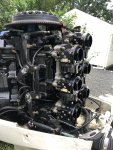festerized
Cadet
- Joined
- Aug 14, 2005
- Messages
- 29
1997 Johnson 225 Idle screw and vacuum leak
Motor: SJ225TXEUD
Idle screw adjustments on starboard top cylinder makes no change to rpm’s, if I turn two turns out and with 0 turns after a few minutes she stalls. Why it takes so long to change rpm’s is baffling, all other cylinders have a instant change to rpm’s.
Motor starts right up, motor surges after 3,000 rpm’s while in gear.
This all started after my primer ball wouldn’t get hard this spring.
I replaced fuel line from tank to fuel separator and added anti stiffen valve, for some reason my tank didn’t have it. I have a new water separator just haven’t installed it yet and don’t feel I need to.
Replaced fuel lines from water separator to deck nipple and replaced deck nipple, only fuel line I did not replace is one going thru 3” motor hose to VRO pump which I will do soon.
I eliminated the fuel system with the exception of the gas line going they the 3” motor hose by running the motor off a 2 gallon external tank.
This is what I have troubleshooted and done so far;
New fuel lines
Ran motor off external tank
Idle mixture screw 5 turns out
All carbs rebuilt
New throttle body gaskets
Switched top carbs to verify it wasn’t carb
Compression test 106 each cylinder
Replaced vacuum line on top cylinder from back of head to throttle body and checked nipples for air leaks. Apparently this is not a cross over vacuum motor as each vacuum line from back of cylinder matches each carb.
Sprayed carb cleaner backside of carbs, no rpm change
If I push in key (choke) motor stalls
Replaced three fuel lines from fuel rail to carbs, waiting on more fuel line to replace remaining.
I will remove and vacuum tested fuel rail this week.
Fuel lines were old and my thought was maybe I loosened when pulling carbs which is sucking in air. Spraying carb cleaner on fuel lines won’t change rpm’s and I don’t know any other way of testing other than just replacing.
Could it be reed valves? No gas is spitting but there is a slight dampness and sometimes a puddle on two middle carbs
Lower unit clutch dog? I watched a few vids on bad clutch dogs, similar but not exactly the same.
Maybe fuel rail cracked and fuel lines are old?
I am stumped
I did not check electrical yet, I’ll attack that next week, I’m stuck on that top carb mixture screw is the problem.
I have a vid of motor running, will try to post
Motor: SJ225TXEUD
Idle screw adjustments on starboard top cylinder makes no change to rpm’s, if I turn two turns out and with 0 turns after a few minutes she stalls. Why it takes so long to change rpm’s is baffling, all other cylinders have a instant change to rpm’s.
Motor starts right up, motor surges after 3,000 rpm’s while in gear.
This all started after my primer ball wouldn’t get hard this spring.
I replaced fuel line from tank to fuel separator and added anti stiffen valve, for some reason my tank didn’t have it. I have a new water separator just haven’t installed it yet and don’t feel I need to.
Replaced fuel lines from water separator to deck nipple and replaced deck nipple, only fuel line I did not replace is one going thru 3” motor hose to VRO pump which I will do soon.
I eliminated the fuel system with the exception of the gas line going they the 3” motor hose by running the motor off a 2 gallon external tank.
This is what I have troubleshooted and done so far;
New fuel lines
Ran motor off external tank
Idle mixture screw 5 turns out
All carbs rebuilt
New throttle body gaskets
Switched top carbs to verify it wasn’t carb
Compression test 106 each cylinder
Replaced vacuum line on top cylinder from back of head to throttle body and checked nipples for air leaks. Apparently this is not a cross over vacuum motor as each vacuum line from back of cylinder matches each carb.
Sprayed carb cleaner backside of carbs, no rpm change
If I push in key (choke) motor stalls
Replaced three fuel lines from fuel rail to carbs, waiting on more fuel line to replace remaining.
I will remove and vacuum tested fuel rail this week.
Fuel lines were old and my thought was maybe I loosened when pulling carbs which is sucking in air. Spraying carb cleaner on fuel lines won’t change rpm’s and I don’t know any other way of testing other than just replacing.
Could it be reed valves? No gas is spitting but there is a slight dampness and sometimes a puddle on two middle carbs
Lower unit clutch dog? I watched a few vids on bad clutch dogs, similar but not exactly the same.
Maybe fuel rail cracked and fuel lines are old?
I am stumped
I did not check electrical yet, I’ll attack that next week, I’m stuck on that top carb mixture screw is the problem.
I have a vid of motor running, will try to post





















